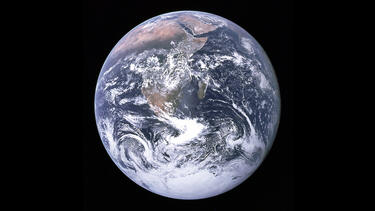Consumption, Numbers and Time: The Arithmetic of Sustenance
On the 50th anniversary of the first Earth Day in 1970, Yale SOM’s Shyam Sunder writes that humankind must grapple with a fundamental threat to our survival.

History has seen many waves of globalization. The current one is different because it is less a matter of choice and more driven by shared constraints on resources. How much each of us consumes, and how many of us live on this earth will determine how long humans survive. There is no escape from the simple arithmetic of consumption (C), numbers (N), and time (T). Environmental, sustainability, and climate change movements may give us a few more years. However, unless supplemented by other efforts, they will not save our species from the resource-driven starvation, pestilence, and wars we are hurtling towards.
Consumption and reproduction have been and remain the basic values of human societies. The two lie at the root of our moral codes. Even virtue is promoted with the promise of entitlement to more consumption in the future. Development, prosperity, and welfare are euphemisms for higher consumption. There is little support for the goal of reducing per capita consumption. Sustainability conferences are well-supplied with bottled water in disposable plastic that are beginning to show up in islands of trash floating in the oceans. Moral values are defined for individuals; the burden of their aggregate consequences on society can be unacceptable.
Reproduction, preservation, and prolongation of life is embedded into our psyche as the other ultimate value, both biologically and socially. Such instincts and norms may have served to select and evolve hominids through their millions of years as hunter-gatherers. The discovery of microbes and the introduction of public health in the 19th century began to lower the death rate in various parts of the world. But the birth rates do not decline until a generation or two later.
As the absolute birth rates decline in most parts of the world, this time lag results in a rapid increase of our numbers, which quadrupled from 1.6 to 6.8 billion over the 20th century and continue to rise faster than 1% each year. Even the low forecasts have the population peaking above 8 billion later this century.
Even if we ignore the expected rises in per capita consumption and population, for how many years will resources—water, food, energy, minerals, etc.—last? As they become scarcer, rising prices will render some additional harvesting economical. New technologies will almost certainly increase efficiency, but we shall have to be extraordinarily lucky for a long time to depend on either of these to support our current levels of consumption and population.
Waiting for economic growth to stabilize (or reduce, as in Europe and Japan) the population will not generate global C and N which are inconsistent with any T that can be called sustainable. China’s one-child policy—an effective attempt in this direction—is the target of widespread moral disapproval.
Estimates of T are subject to uncertainties of technology, prices, and natural variations. In the context of human history, it is persnickety to argue whether it will take two, four, or six generations of seven-plus billion to exhaust the water, food, and minerals at our standard of living. Socio-political and military conflicts will not await the actual exhaustion.
The environmental discourse cannot continue to avoid dealing with the conflict between resource constraints and the place of consumption and reproduction in our moral code. Decades of political wrangling to reduce carbon emissions to deal with the threat of climate change suggests that agreement is not going to be easy, even if we could find a solution. Who, for example, has the stomach for imposing the Chinese solution in democratically ruled countries, if that were the chosen route? The severe demographic, economic, and social dynamics of such a solution will reverberate for centuries. Even if we did so, the arithmetic of C, N, and T may tell us we already have crossed the point of no return. Could this be why the subject is rarely on agenda of international conferences?
The environmental movement has focused on cleaning the beaches, so to speak, while a tsunami is on the horizon. The only way to sustainable existence is when every used resource (and its substitutes) is either renewable or available in unlimited quantities. Painful and extreme as the ways of ensuring the CNT consistency might be, perhaps they are preferable to starvation, disease, and war. Validity of claims to human exceptionalism must by supported by our deliberative ability to devise an orderly global solution which does not depend on letting the nature take its course—the way every other species has followed to extinction so far.